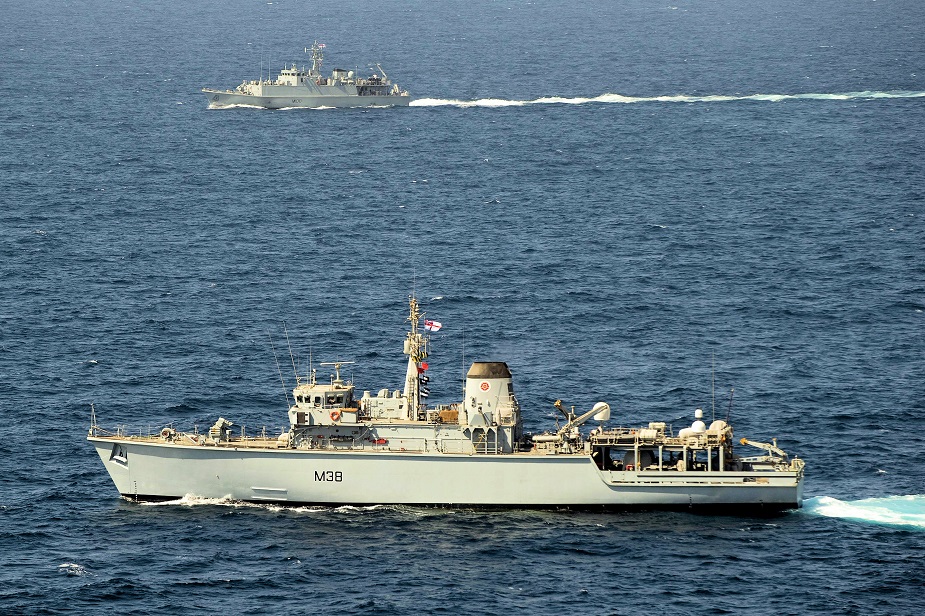Thales UK’s most advanced new mine countermeasures (MCM) sonar has been accepted for use by the Royal Navy after the successful completion of intensive sea trials. The 2093 variable depth sonar has been in worldwide operational service with naval forces since it was developed in the 1980s. The system is the mainstay of the Royal Navy’s MCM capability and is fitted in its Sandown class minehunters.
 HMS Grimsby’s six sister ships will all be refitted with 2093 CSP at the Royal Navy’s dockyard in Rosyth as part of a multi-million pound contract. Thales picture.
HMS Grimsby’s six sister ships will all be refitted with 2093 CSP at the Royal Navy’s dockyard in Rosyth as part of a multi-million pound contract. Thales picture.
Although operationally proven, an evolving mine warfare environment prompted Thales UK to develop the enhanced 2093 Wideband variant, under the 2093 Capability Sustainment Programme (CSP) for the Royal Navy, providing a step-change improvement in threat recognition capability and range.
This summer, the new variant underwent an intense 12-week sea acceptance trial on the Navy’s Sandown class minehunter HMS Grimsby in its BUTEC test ranges off the coast of Scotland.
"This is a unique system; there is nothing like it in the world. We like to think of the Royal Navy’s expertise in mine warfare as being world-leading, and this really is up there." said Lieutenant Commander Kev Giles,
Royal Navy mine warfare specialist, Royal Navy headquarters, Portsmouth. “The picture the sonar provides the operator is much clearer, the detection range is much greater and it should only detect physical objects – rocks, debris, mines – and not be tricked by noise.”
Nathan Noall, Project Manager for 2093 CSP at Thales UK, said: “Getting the Sea Acceptance Trials done on this “first of class” ship is a huge plus. The trials weren’t without challenge but we’ve ultimately come up with a system that’s been accepted by the Royal Navy and 2093 CSP delivers on all they’ve asked for.”
Chris Shepherd, MCM Sector Director, said “We are immensely proud to have delivered 2093 Wideband into service with the Royal Navy and to have had such positive feedback throughout the acceptance trials.”
Thales UK’s Jon Hirst, who conducted the acceptance trials at sea on board HMS Grimsby, said: “The crew were very pleased by the system’s reliability. We drove the system hard during the trials periods and it came through very well.”
HMS Grimsby’s six sister ships will all be refitted with 2093 CSP at the Royal Navy’s dockyard in Rosyth as part of a multi-million pound contract.
2093 Wideband: technical details
2093 Wideband is a multi-frequency variable depth sonar system designed to counter the threat of modern mines in both deep and shallow water. Its sonar transmitter and receiver are contained within a towed body which is lowered below the ship by automated winch of armoured cable, penetrating oceanic temperature layers which can block sonar signals.
The new wideband capability has evolved from Thales’s world-leading 2193 hull-mounted sonar, which has been in service on the Royal Navy’s Hunt-class minehunters for a decade, giving it an extensive deep water performance previously only seen in shallow waters. Pulse compression technology allows long range detection and classification of new generation, low target strength mines, while wider fields of view and multiple search and classification frequencies ensure that the critical mine hunting parameters of ‘coverage rate’ and ‘speed of advance’ are maximised under any operational conditions. 2093 Wideband’s human-computer interface has also been converged with 2193, making familiarisation training quicker for sonar operators from Hunt Class ships.
Export potential
Thales UK already has a contract to deliver 2093 Wideband to South Korea and naval forces in Asia, the Middle East and Europe have already shown interest in the new system and Nathan is confident about the new product’s export market prospects.










